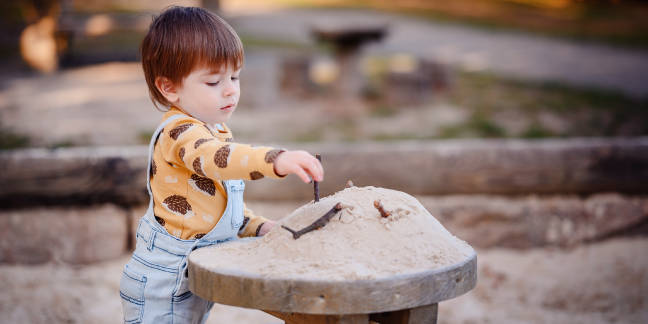We often think of STEM learning as something that happens at a table with blocks, worksheets, manipulatives, or carefully planned lessons. But step outside, and suddenly the world becomes a hands-on, minds-on laboratory where every stick, puddle, bug, and breeze can spark scientific discovery.
The outdoors naturally invites curiosity. Children notice patterns in nature, test ideas with their bodies, and invent solutions using whatever materials they find. These early wonderings and experiments are the foundation of STEM thinking, long before we introduce formal science tools or vocabulary.
Nature Encourages Scientific Inquiry
Every outdoor moment offers questions worth exploring:
- Why does the shadow move?
- Where do worms go when it rains?
- What makes a pinecone open or close?
- How can I make this sand tunnel stay standing?
Children learn to observe, ask questions, make predictions, and test ideas; the same habits scientists use every day. Even something as simple as pouring water from one container to another becomes an experiment in gravity, force, and volume.
Dr Angela Eckhoff, author of Creative Investigations in Early Science notes,” The natural curiosity of young students provides early childhood educators with an entry point from which to build classroom science experiences. Inquiry-based early childhood science education capitalizes on the interests young children demonstrate as they explore the world around them.”
Engineering Through Play
Loose-parts play flourishes outdoors. Sticks become bridges. Rocks become weights. Mud becomes mortar. Children build, balance, stack, dig, and design — then revise their creations when they topple or crack. This trial-and-error process strengthens spatial awareness, persistence, and flexible thinking.
The best part? There is no “right” answer outdoors. Children are free to take risks, solve problems their own way, and discover new possibilities.
And when children roll balls down hills or toss pebbles into puddles, they’re experiencing early physics and data-gathering: Which one rolls farther? How deep does the splash go?
Sensory-Rich Learning Builds Strong Thinkers
Nature is the ultimate multi-sensory classroom. Squishy mud, rough bark, crunchy leaves, warm sun, chilly wind — every sensation strengthens brain connections. These rich sensory moments build vocabulary, deepen understanding, and keep children engaged longer than any worksheet ever could.
In Loose Parts Alive, authors Carla Gull and Laura Wilhelm show how everyday moments outdoors can become meaningful learning sparks. A fish gliding through water can launch STEM questions and discoveries. Sunlit leaves fluttering on a branch may invite children to create art or explore light and shadow. Watching a caterpillar transform can open the door to rich vocabulary, curiosity, and awe.
Supporting Outdoor STEM Learning
Educators don’t need special equipment to nurture STEM thinking outside. Try these simple strategies:
- Wonder aloud: “I wonder why the water stopped flowing there.”
- Encourage observation: “What do you notice about these leaves?”
- Offer open-ended materials: buckets, sticks, ramps, magnifying tools.
- Give time: True discovery needs uninterrupted play.
- Invite documentation: charts, photos, drawings, nature journals.
Most importantly, follow the child’s curiosity. When we slow down and see nature through their eyes, even a patch of grass becomes a universe of learning.
The Joy of Discovery
Outdoor play isn’t just good for bodies — it fuels brilliant, flexible, curious minds. When children climb, splash, dig, collect, and explore, they’re building the habits of lifelong learners: resilience, creativity, collaboration, and wonder.
STEM learning begins with curiosity — and there is no better place to spark it than under the open sky.
Explore STEM learning resources in our STEM book collection from Gryphon House.

